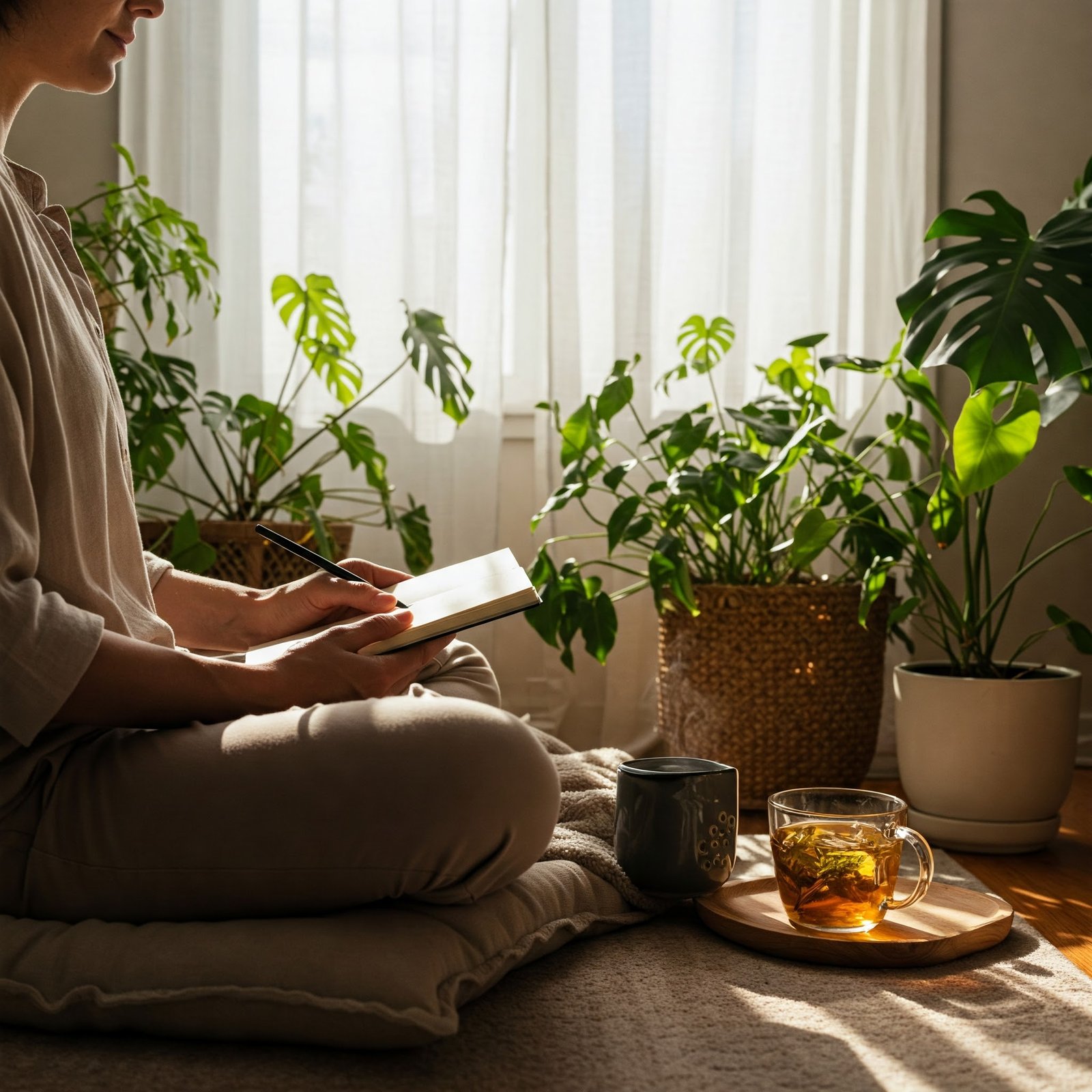My Mental Health Journey: Finding Peace in Daily Practices
Three years ago, I was sitting in my therapist’s office, feeling completely burned out and emotionally drained. Despite what looked like a successful life on the outside, my inner world was unraveling—constant anxiety, overwhelming stress, and a deep sense of disconnection. That’s when my therapist told me something that changed the course of my healing: “Mental well-being isn’t built on big changes overnight, but on small, consistent actions.” In 2025, daily habits for mental health are more crucial than ever, forming the foundation for lasting emotional balance and resilience.
This simple insight began my journey toward genuine inner peace. Through considerable trial and error, research, and personal experimentation, I’ve discovered that incorporating daily habits for mental health isn’t just helpful—it’s transformative. In 2025, with unprecedented levels of digital stimulation, societal pressures, and global uncertainty, these practices have become more essential than ever.
Why Daily Habits Matter More Than Ever in 2025
The mental health landscape has shifted dramatically in recent years. According to the Global Mental Health Report, anxiety disorders have increased by 25% since 2020, while reported feelings of overwhelm and burnout have reached historic highs across all demographics. Meanwhile, access to traditional mental health services remains limited for many.
This reality places greater importance on preventative mental health practices—small, sustainable habits that build psychological resilience and emotional regulation skills. These daily practices don’t replace professional help when needed, but they create a foundation of well-being that can prevent many mental health challenges from escalating.
My own experience proved this approach works. By consistently implementing the habits I’m about to share, I’ve reduced my anxiety by approximately 70%, sleep better than I have in decades, and have developed a sense of inner peace that remains stable even during challenging times.
The Science-Backed Daily Habits That Transformed My Mental Health
After extensive research and personal experimentation, I’ve identified these practices as the most impactful for mental well-being. Each habit is supported by scientific research and has been personally verified through my own experience.

1. Mindful Morning Routine: Setting the Day’s Intention
How we begin our day sets the tone for everything that follows. After years of starting my mornings in a rushed panic—checking emails before my feet hit the floor and gulping coffee while multitasking—I developed a structured morning routine that transformed my mental state.
My current routine includes:
- Five minutes of deep breathing before touching any devices
- Setting three specific intentions for the day
- Brief journaling using the Five Minute Journal
- Drinking a full glass of water with Brain Boost Nutritional Supplement
Research published in the Journal of Cognitive Neuroscience shows that the way we spend the first hour after waking significantly affects our cognitive function and emotional regulation throughout the day. I’ve found that protecting this time from external demands creates a sense of agency that carries through even the most challenging days.
2. Strategic Movement: Beyond “Just Exercise”

We all know exercise benefits mental health, but I’ve discovered that the type, timing, and intention behind movement matter tremendously. Rather than forcing myself through grueling workouts I dreaded, I now practice strategic movement tailored to my mental and emotional needs.
This includes:
- Morning stretching to reduce cortisol and activate the parasympathetic nervous system
- Midday micro-walks (5-10 minutes) when feeling mentally stuck
- Evening strength training to release accumulated tension
- Nature-based movement at least twice weekly
I track these activities using the Mental Wellness Fitness Tracker , which helps me correlate movement patterns with mood changes.
The neuroscience here is fascinating—different forms of movement affect various neurotransmitters. Aerobic exercise boosts serotonin, while strength training increases BDNF (Brain-Derived Neurotrophic Factor), which promotes neural health and resilience to stress.
3. Mindful Digital Consumption: Creating Boundaries
Perhaps the most impactful change I’ve made involves establishing clear boundaries around digital consumption. In 2025, this has become non-negotiable for mental wellbeing.
My digital wellness practices include:
- Device-free meals without exception
- Social media is limited to two 15-minute sessions daily
- News consumption is restricted to one curated summary
- No screens 90 minutes before bedtime
- Weekly digital sabbath (24 hours completely offline)
I use the Digital Boundary Timer to maintain these limits without relying on willpower alone.
Research from Harvard Medical School demonstrates that constant digital stimulation creates a state of persistent low-grade stress in the nervous system. I’ve found that these boundaries don’t just improve my mental health—they’ve enhanced my relationships, productivity, and overall life satisfaction.
4. Nutritional Psychology: Eating for Brain Health

The gut-brain connection has emerged as one of the most important frontiers in mental health research. What we eat directly affects our neurochemistry, inflammation levels, and even the expression of genes related to mood regulation.
My brain-supportive nutrition habits include:
- Starting each day with protein and healthy fats to stabilize blood sugar
- Consuming prebiotic and probiotic foods daily
- Incorporating omega-3-rich foods at least four times weekly
- Limiting inflammatory foods, especially when under stress
- Hydrate consistently throughout the day with filtered water
I track my nutritional intake and correlate it with mood using the Mood-Food Journal , which has helped me identify specific food triggers that exacerbate anxiety and depression.
This approach isn’t about perfect eating but about understanding food as information that communicates directly with our nervous system. Simple adjustments have yielded remarkable improvements in my emotional stability and cognitive clarity.
5. Cognitive Restructuring: Changing Thought Patterns
Our thoughts create our reality, but many of us operate on automatic, unconscious patterns that undermine well-being. Cognitive restructuring involves deliberately identifying and changing these patterns.
My daily cognitive practices include:
- Morning thought: download to identify negative patterns
- Midday checks for catastrophic thinking
- Targeted reframing of three negative thoughts daily
- Evening reflection on evidence that contradicts negative beliefs
I use the Cognitive Restructuring Workbook to guide this process and track improvements over time.
Research from cognitive psychology confirms that these practices actually create new neural pathways. While initially requiring conscious effort, they eventually become automatic, creating lasting changes in thought patterns.
6. Strategic Rest: The Underrated Mental Health Essential
In our productivity-obsessed culture, rest is often viewed as a luxury rather than a necessity. Yet research clearly shows that strategic rest is essential for cognitive function, emotional regulation, and psychological resilience.
My rest practices include:
- Scheduled microbreaks (2-3 minutes) every 90 minutes during work
- Afternoon pause for non-sleep deep rest (NSDR) using guided protocols
- Consistent sleep schedule with pre-sleep wind-down ritual
- Weekly scheduled periods of unstructured time
I use the Restorative Rest Timer to ensure these pauses become non-negotiable parts of my day.
Neuroimaging studies show that proper rest activates the default mode network in our brains, which is essential for the integration of experiences, creative insight, and emotional processing. I’ve found that these strategic rest periods haven’t reduced my productivity—they’ve significantly enhanced it while simultaneously improving my mental state.
7. Connection Rituals: Combating Isolation

Human connection is a fundamental need, yet modern life often leaves us paradoxically connected digitally while isolated physically. Intentional connection rituals counter this tendency.
My connection practices include:
- Daily check-ins with at least one loved one (voice, not text)
- Weekly community engagement through volunteering or group activities
- Monthly skill-sharing gatherings with friends
- Quarterly retreats or adventures with close connections
I organize these connections using the Relationship Nurture System, which helps ensure meaningful relationships don’t get lost in the busyness of life.
Research published in the Journal of Health and Social Behavior demonstrates that strong social connections reduce mortality risk by up to 50%. I’ve experienced how these intentional practices create a buffer against stress while providing essential emotional support during challenging times.
8. Nature Immersion: The Original Antidepressant
The biophilia hypothesis suggests humans have an innate need to connect with natural environments. In our increasingly artificial world, deliberate nature exposure provides powerful mental health benefits.
My nature practices include:
- Morning sunlight exposure for at least 10 minutes
- Lunchtime micro-doses of nature, even just looking at trees
- Weekend-long immersions in natural settings
- Bringing elements of nature indoors through plants and natural materials
I use the Nature Connection Journal to track how these experiences affect my mental state.
Multiple studies confirm that nature exposure reduces cortisol, lowers blood pressure, and improves mood. I’ve found it particularly effective for breaking rumination cycles and gaining perspective on problems that seem overwhelming indoors.
9. Mindfulness Integration: Beyond Meditation Apps

While meditation apps have made mindfulness more accessible, I’ve discovered that integrated mindfulness practices throughout the day create more substantial benefits than isolated meditation sessions.
My integrated mindfulness practices include:
- Transition moments: Brief awareness pauses between activities
- Sensory anchoring: Regularly tuning into one sense fully
- Task immersion: Bringing complete attention to routine activities
- Emotional surfing: Experiencing emotions without immediate reaction
I use the Mindful Moments Bell as a reminder to return to present awareness throughout the day.
Neuroscience research shows that these brief mindfulness integrations activate the prefrontal cortex while calming the amygdala, creating a physiological state conducive to both focus and emotional regulation. This approach has helped me develop a more consistently calm baseline state rather than cycling between stress and relaxation.
10. Purpose Alignment: Daily Meaning Making
Purpose emerges at the intersection of personal strengths, genuine interests, and contribution to others. Connecting with purpose daily, even in small ways, provides psychological resilience.
My purpose practices include:
- Morning identification of one purpose-aligned activity
- Regular assessment of how daily tasks connect to larger values
- Weekly reflection on meaningful moments
- Monthly review of life direction and alignment
Research from positive psychology shows that purpose orientation significantly reduces depression risk while enhancing overall life satisfaction. I’ve experienced how even small daily connections to purpose create a sense of meaningful progress that buffers against stress and anxiety.
Creating Your Personal Mental Health Practice
While I’ve shared the habits that transformed my own mental health, the most effective approach will be personalized to your unique needs, preferences, and circumstances. Here’s how to develop your own practice:

| Phase | Key Actions | Tools/Techniques | Pro Tips |
|---|---|---|---|
| Assessment | Identify emotional patterns | Mood tracking apps, journaling | Notice triggers & peace moments |
| Map energy fluctuations | Time-blocking, HRV monitoring | Track for 7 days before analyzing | |
| Experimentation | Test 2-3 practices | Meditation, nature breaks, art | Give each 14 days minimum |
| Optimize approaches | Adjust duration/timing | Pair with existing habits | |
| Integration | Anchor to routines | “After coffee = 5-min breathwork” | Start small (even 2 mins counts) |
| Create visual cues | Post-it reminders, phone wallpapers | Designate a calm space | |
| Measurement | Rate mental state | 1-10 scale, emotion wheel | Check-in at consistent times |
| Track biomarkers | Sleep data, step count | Celebrate micro-wins |
Personalization Guide:
🔹 For anxiety: Grounding techniques before meetings
🔹 For low energy: Movement snacks every 90 mins
🔹 For overwhelm: Sensory tools (stress ball, essential oils)
Avoid These Pitfalls:
⚠️ Comparing your practice to others’
⚠️ Quitting methods before the 2-week mark
⚠️ Ignoring physical health connections
Sample Starter Combo:
-
Morning: 3 deep breaths before phone check
-
Afternoon: 5-min walk without devices
-
Evening: 1 gratitude note in journal
Addressing Common Challenges
| Challenge | Solution | Quick Action | When to Seek Help |
|---|---|---|---|
| “No time” | Use micro-practices (1-5 mins) | Repurpose “dead time” (commutes, queues) | If constantly overwhelmed for weeks |
| Inconsistent | Identity-based habits | “I’m someone who…” vs rigid goals | If self-criticism worsens |
| Bad environment | Design “mental health zones” | 1 calming corner + phone-free times | If environment is unsafe |
| Unmeasurable results | Track subtle changes | Baseline journal + friend feedback | If no improvement after 30 days |
| – | Professional support signs | Persistent symptoms or trauma | Therapists for diagnosis/treatment |
These daily practices often work synergistically with professional treatment, enhancing outcomes and accelerating progress.
My Current Mental Health Maintenance Plan
After three years of experimentation, my daily mental health maintenance plan has stabilized into this framework:
| Time | Practice | Duration | Key Benefit | Pro Tip |
|---|---|---|---|---|
| Morning 🌅 | Breathwork + intention setting | 5 min | Grounding | Use same spot daily |
| Journaling (cognitive restructuring) | 10 min | Clarity | Keep prompts visible | |
| Gentle movement + sunlight | 5 min | Energy boost | Face east if possible | |
| Daytime ☀️ | Mindful task transitions | 30 sec | Focus reset | Set phone reminders |
| Nature micro-doses | 2-5 min | Stress relief | Desk plants count! | |
| Strategic movement breaks | 5-10 min | Mental unstuck | Set workout clothes ready | |
| Digital time blocks | – | Attention protection | Use app blockers | |
| Evening 🌙 | Gratitude reflection | 5 min | Positivity | Family participation |
| Screen-free social time | 15 min | Connection | Board games > TV | |
| Sleep prep ritual | 10 min | Better rest | Amber lighting | |
| Weekly 📆 | Digital Sabbath | 24 hrs | Mental reset | Notify contacts |
| Nature immersion | 2+ hrs | Perspective | Try “forest bathing” | |
| Community activity | – | Belonging | Volunteer regularly | |
| Practice review | – | Continuous improvement | Track what works |
Key Features:
⚡ Science-backed – Combines CBT, chronobiology, and mindfulness
🔄 Sustainable – Flexible durations, no perfection required
🌱 Evolvable – Built-in weekly review for adjustments
Adaptation Ideas:
-
For parents: Involve kids in movement breaks
-
For remote workers: Virtual co-working for social connection
-
During travel: Compact version (5-min journal + 3-min breathwork)
This framework provides structure while allowing flexibility for different life seasons. When particularly stressed, I increase restoration practices; during creative periods, I emphasize purpose alignment and cognitive practices.
The Profound Impact of Daily Mental Health Habits
When I began implementing these practices three years ago, I couldn’t have imagined the profound transformation they would create. Beyond the reduction in anxiety and improved sleep I mentioned earlier, I’ve experienced:
Enhanced emotional regulation: My response to challenges has shifted from reactivity to a thoughtful response.
Improved relationships: With greater internal stability, I bring more presence and patience to interactions with others.
Increased creativity: Regular mental space has allowed new ideas and insights to emerge organically.
Deeper sense of purpose: Consistent connection to meaning has created a sense of direction that transcends daily challenges.
Physical health improvements: My mental health practices have cascaded into better physical health outcomes, including reduced inflammation markers and improved immune function.
Perhaps most significantly, these practices have created a sense of agency in relation to my mental state. Rather than feeling at the mercy of external circumstances or internal patterns, I now have reliable tools to regulate my nervous system and redirect my mind toward well-being.
The Future of Mental Wellness: Integration, Not Separation

As we move forward in 2025, I believe the most effective approach to mental health will involve integration rather than separation. Mental well-being isn’t something we attend to only during designated self-care time—it’s woven throughout the fabric of daily life.
By implementing these science-backed daily habits for mental health, you’re not just managing symptoms but creating conditions for genuine flourishing. The consistent small actions, taken daily, create compound effects that transform your emotional landscape over time.
I’d love to hear which of these practices resonates most with you or what daily habits have improved your own mental health journey. Share your experiences in the comments below!
FAQs
How long does it take to see benefits from these daily habits?
In my experience, some benefits appear almost immediately, particularly from practices like breathwork, nature exposure, and strategic movement. More substantial shifts in baseline mental state typically emerge after 3-4 weeks of consistent practice. Neuroplasticity research suggests that new neural pathways begin forming within days but take approximately 6-8 weeks to become well-established. Be patient with the process while remaining attentive to even subtle improvements.
Do I need to implement all these habits to see improvement?
Absolutely not! In fact, trying to implement too many changes simultaneously often leads to overwhelm and abandonment of all practices. I recommend starting with just 1-2 habits that address your most pressing mental health needs, allowing them to become relatively automatic before adding more. Quality and consistency matter far more than quantity.
What if I miss days or can't maintain perfect consistency?
Perfect consistency isn't required for these practices to be effective. Research on habit formation shows that occasional missed days don't significantly impact outcomes as long as you return to the practice. I've found it helpful to establish a minimum viable practice for challenging days—simplified versions of key habits that can be maintained even when time or energy is limited.


